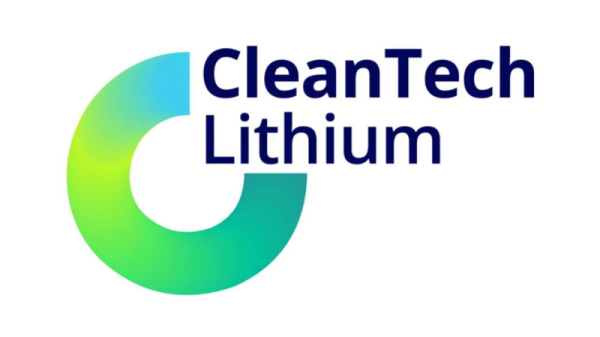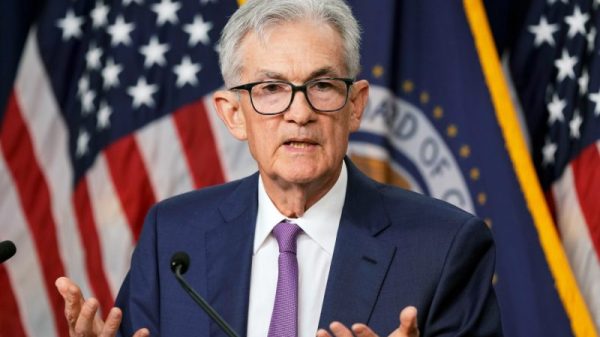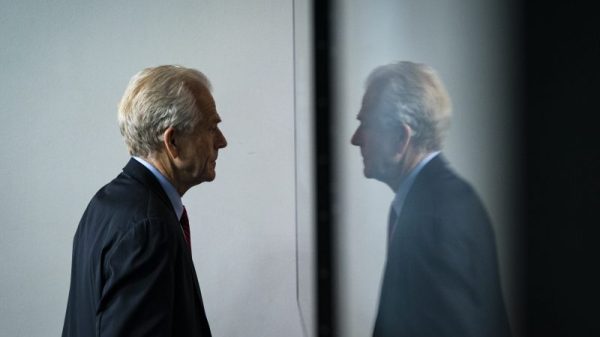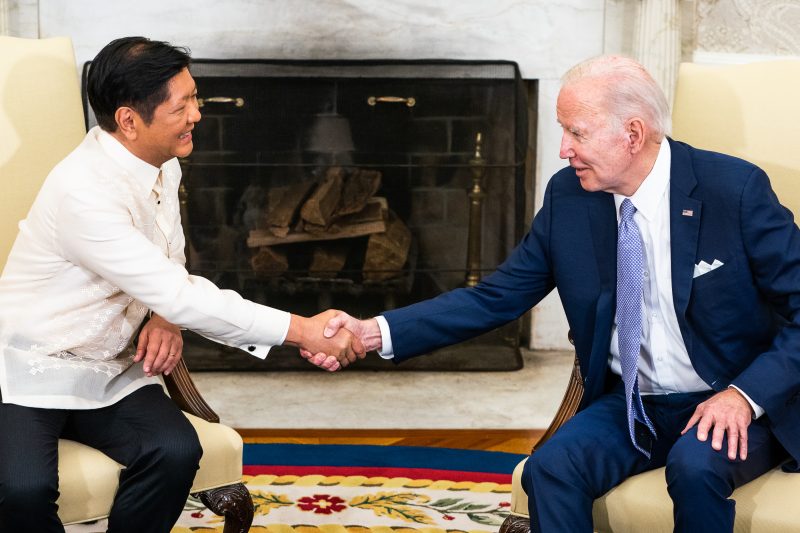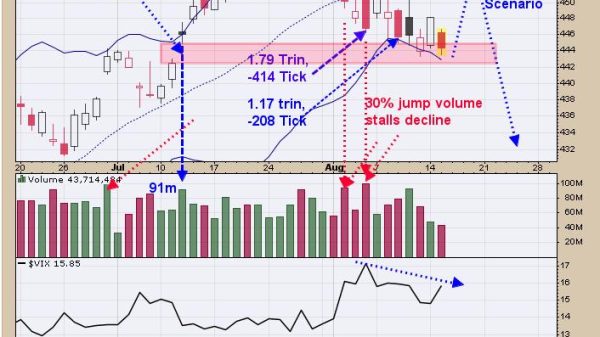As President Biden met with heads of state around the world these past couple of years, he’s been repeating a curious phrase.
“Open RAN.”
This obscure technology for cellular towers — which the Brookings Institution once dubbed the “Huawei killer” — is Washington’s anointed champion to try to unseat Chinese tech giant Huawei Technologies from its throne as the largest supplier of the “pipes” that carry the world’s internet data and phone calls.
Open radio access networks, or Open RAN, is an emerging technology for cell towers that allows for the use of mix-and-match parts from different vendors — a little akin to Google’s Android ecosystem. This diverges from the Apple-esque, proprietary, all-in-one systems from Huawei, Ericsson and Nokia that dominate the market. U.S. officials hope that this new initiative will help U.S. vendors get back in a game they were largely squeezed out of during two decades of globalization.
Biden’s personal appeals to the leaders of India, the Philippines, Saudi Arabia and other countries reflect the issue as a top priority in Washington. A broad administration push is underway to persuade countries around the world to say “yes” to Open RAN and “no” to Huawei.
“This has been a whole-of-government approach,” Alan Davidson, assistant secretary of commerce and National Telecommunications and Information Administration (NTIA) administrator, said in an interview. “We’ve been working very closely with the State Department, with the White House. …We’re trying to bring all the tools that we have to bear.”
The federal departments and agencies involved span a remarkable range of government entities: the State, Commerce and Defense departments; NTIA; the U.S. Trade and Development Agency (USTDA); the U.S. Agency for International Development (USAID); U.S. International Development Finance Corporation, and the Export-Import Bank of the United States.
Congress has allocated half a billion dollars to the State Department to spend on advancing the development and adoption of Open RAN and secure-semiconductor technologies over five years, while NTIA has a $1.5 billion fund to invest in research, testing and promotion of Open RAN technologies over a decade. Other agencies like USTDA have also carved out parts of their budgets to advocate for the technology.
Open RAN technology originated as an internationalized concept with no special U.S. ties in the late 2010s, with companies like AT&T and China Mobile working together on it. Then the Trump administration began promoting the nascent technology, considering it advantageous for smaller U.S. players, in what some scholars have described as a “geopolitical hijacking.” The Biden administration has intensified the Open RAN push as the technology has become more ready for the market.
In the latest move, NTIA is set to announce Monday a $42 million grant to open a testing center for Open RAN devices in the Dallas area, with an aim to boost global confidence in the technology by verifying that different vendors’ products can work together without glitches or cybersecurity vulnerabilities. In a signal of the administration’s global ambitions, Japan’s NTT Docomo and India’s Reliance Jio were brought in as members of the project, alongside AT&T, Verizon and several U.S. universities.
The Open RAN initiative has its share of skeptics, with some considering it a half-baked technology being forced down other nations’ throats for U.S. gain. There has been mixed reception in Europe, where Sweden’s Ericsson and Finland’s Nokia stand to lose business to U.S. upstarts.
“The discussion about Open RAN gives the impression that only this approach can be trustworthy,” said Bastian Pauly, spokesperson for Germany’s Federal Ministry for Digital and Transport. “The German federal government is pursuing a market-oriented approach in which the market should decide whether Open RAN is advantageous over proprietary closed systems. The position is also shared by European partners and allies.”
An E.U. Commission spokesperson said in a statement that there is now a “significant” market trend toward Open RAN, which made addressing the cybersecurity risks of the technology particularly important.
“Especially in the short term, by introducing a new approach, new interfaces and new types of RAN components potentially coming from multiple suppliers, Open RAN can lead to a number of security risks of 5G networks and expand the attack surface in the radio access part of the network,” the E.U. Commission spokesperson said.
Adam Koeppe, Verizon’s senior vice president of technology planning, said that a major goal of the new testing center funded by NTIA will be to ensure cybersecurity of Open RAN devices.
“Security will be a critical component of that,” he said. “It is likely that will be a specific focus in one of the lab locations.”
This quiet battle over Open RAN is emblematic of the technological arms race between the United States and China, which has spread to other strategic technologies like semiconductors and artificial intelligence that are critical for both the civilian economy and the military.
Some policy observers warn that Washington and Beijing are inching closer to a devastating war by pushing into hyperdrive their development of technologies with military applications. Others retort that it would be naive to be unprepared.
Telecommunications gear has loomed large in these deliberations, due to its obvious utility for intelligence agencies in signals intelligence-gathering in peacetime, and the risk of a disastrous cutoff of communications by an adversary in the case of a war. After decades of globalization and industry consolidation, more than half the global supply of these “pipes” come from only four vendors: China’s Huawei and ZTE, and Scandinavia’s Ericsson and Nokia. After many of the earlier U.S. heavyweights died out, U.S. contenders remaining in this space include Mavenir, Airspan and Radisys.
U.S. officials are perturbed that Huawei remains No. 1 in global market share despite a full-court press from Washington including multiple rounds of sanctions and are afraid that it could give Chinese intelligence operatives an edge. Huawei, for its part, has sworn up and down it doesn’t help the Chinese government spy, even as legal scholars say the company may not have a choice under Chinese national security laws.
It is almost universally accepted that intelligence agencies seek access to such networks: As one of the more public examples, former National Security Agency contractor Edward Snowden revealed in 2013 that the NSA was paying hundreds of millions of dollars a year to U.S. companies like AT&T for clandestine access to their communications networks.
The NTIA-funded test center is the latest of a string of efforts by the U.S. government to promote Open RAN around the world, especially in countries viewed as battlegrounds between the United States and China for influence. Davidson, the assistant commerce secretary, said his team has made outreach efforts in India and Palau.
USTDA, which has a mission of helping to create U.S. jobs through the export of U.S. goods and services for priority infrastructure projects in emerging economies, has allocated $7.8 million toward the development of Open RAN infrastructure in 14 emerging economies since 2020, according to a USTDA spokesperson. Around $5.8 million of the funding came from USTDA’s core appropriations, with the rest from transfer funds from the State Department’s Digital Connectivity and Cybersecurity Partnership.
In Brazil, the U.S. Embassy is using a $2 million grant to set up an Open RAN test bed in conjunction with the Brazilian telecommunications research lab CPQD. The Commerce Department flew a Brazilian delegation to Las Vegas in September to meet with U.S. Open RAN vendors, and to visit a testing center for the technology in Dallas.
In Indonesia, the country’s Ministry of Communication and Informatics began a study in January to evaluate the feasibility of deploying Open RAN in 1,621 villages lacking mobile coverage, in a project funded by USTDA.
A similar study funded by USTDA in Nigeria for Lagos-based Hotspot Network Limited resulted in Hotspot deciding to proceed with a rollout in August. “The project has generated U.S. exports and local development outcomes,” the USTDA spokesperson said.
Turkey’s Turk Telekom has received $1.6 million from USTDA to explore using the technology. USTDA said it also flew telecom industry delegations from Malaysia, Thailand and Vietnam to the United States to learn about Open RAN in 2022 and 2023.
In the Philippines, USAID launched the Asia Open RAN Academy in June 2022 in partnership with Japan’s government to evangelize Open RAN in the region. A USAID spokesperson said the academy has trained over 15,000 engineers and policymakers in the Philippines in Open RAN technology, and that USAID also has Open RAN projects in rural villages in Peru and the Democratic Republic of Congo.
The spokesperson said USAID coordinates “regularly and closely” with the State and Commerce Departments and USTDA on Open RAN projects “to make sure we are all pulling in the same direction.”
“We never thought it would catch on like it has,” said Diane Rinaldo, executive director of the Washington-based Open RAN Policy Coalition, a lobbying organization representing companies that make the technology. “The first day we launched our website, the woman who runs the site reached out to me, and she said, ‘You got a message from a regulator in South Africa.’ I said, ‘What?’”
Biden has involved himself in the Open RAN evangelizing, with the issue mentioned in the official readouts of his meetings with Philippine President Ferdinand Marcos Jr. in May and Indian Prime Minister Narendra Modi in June, among others.
“This new technology solution for 5G, called Open RAN, will outcompete other platforms, including from China,” Biden said in a speech in Jeddah, Saudi Arabia, in 2022, after meeting with Saudi leadership.
“The president is with it. The president is on it,” said Davidson, about Biden’s fluency on Open RAN and personal involvement on its promotion.
In October, the United States, United Kingdom, Australia, Canada and Japan announced the formation of the pro-Open RAN Global Coalition on Telecommunications (GCOT). Davidson said there is a desire to grow the group.
Germany – Europe’s largest economy, and a notable holdout from toeing the Washington line on a blanket ban on Huawei and ZTE equipment – has been noncommittal. Responding to the question of whether Germany would join GCOT, Pauly replied that, “from a European perspective, network suppliers such as Nokia and Ericsson already offer secure and trustworthy solutions.”
Despite the flurry of diplomatic activity, few major telecom operators around the world have committed to major purchases. The research firm Dell’Oro Group estimates that Open RAN will make up only 7 to 10 percent of the global market by revenue in 2024, with an upside estimate of 30 percent by 2028. John Strand, a veteran industry consultant based in Denmark, said many mobile operators remain wary about the complication and risk of juggling multiple vendors.
“If you had the choice to buy a solution from one supplier, and he had the responsibility for the end-to-end solution, why should you buy solutions from four different suppliers and then end up in a situation where if something goes wrong, you don’t know about supplier A, B and C’s responsibility?” Strand said. “That’s what the operators are saying. That’s the reason why they’re not buying.”
The Open RAN movement got a game-changing boost in December, with AT&T’s announcement of a five-year contract with the Swedish giant Ericsson, worth up to $14 billion, to put 70 percent of AT&T’s wireless traffic on Open RAN-compatible gear by 2026.
With that anchor contract to kick things off, Ericsson is planning to shift all its mobile networking products to be Open RAN-compatible in a “couple years,” Ericsson Executive Vice President Fredrik Jejdling said. Landing Ericsson as an ally instead of a rival is a big win for the Open RAN movement. Jejdling said that 50 percent of the world’s 5G traffic outside of China travels through Ericsson gear.
Jejdling said there was work to be done to better commercialize the technology so it “doesn’t add cost and unnecessary processes.”
Alok Shah, vice president of networks strategy for Samsung Electronics’ U.S. division, said that the two primary markets for Open RAN now are the United States and Japan, but “Europe is the next one.” He said that some operators are hedging their risk by introducing gear that is Open RAN-compatible from a single vendor, even as they delay the introduction of multiple vendors. South Korea’s Samsung is the No. 5 player in the sector, and Verizon’s chosen supplier to begin deploying some Open RAN gear in Verizon networks.
“We think there’s a lot of value in a single vendor approach to start with, because it takes some of the risk off the table, but it still gives the operator long-term optionality,” Shah said.
Davidson said NTIA’s $1.5 billion Open RAN fund was originally supposed to be spent over a decade, but “with Congress’s blessing,” they plan to disburse it faster, with a focus on areas such research and security. NTIA distributed $140 million in the first year.
“A few years ago, people were questioning whether we would ever be able to have open networks,” Davidson said. “And now, people aren’t asking ‘if.’ They are asking ‘when.’”



